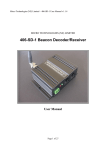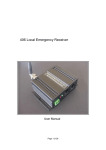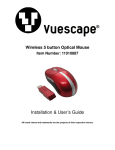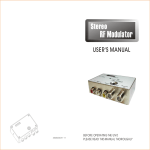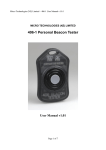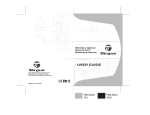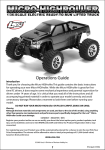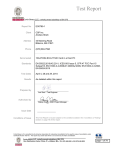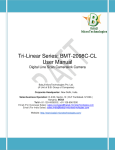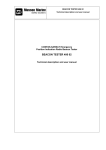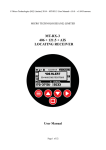Download File - MICRO TECHNOLOGIES (NZ) LIMITED
Transcript
Micro Technologies (NZ) Limited – 406-2 User Manual v1.0.1 MICRO TECHNOLOGIES (NZ) LIMITED 406-2 Beacon Decoder User Manual v1.01 Page 1 of 5 Micro Technologies (NZ) Limited – 406-2 User Manual v1.0.1 Introduction The Micro Technologies 406-2 beacon decoder provides all 406 beacon users a simple method to inspect the transmission from their beacon. This decoder allows the beacon serial number and hex codes to be displayed together with an indication of beacon transmitted power. The 406-2 beacon decoder is small enough to keep with your beacon (able to fit on a keyring), and extremely simple to use and understand with single button operation. No configuration is required and decodes all legitimate 406 beacon transmissions for all 406 beacon types (EPIRB, PLB and ELT). All 406 used beacon frequencies are scanned. Beacon testers until now have been well out of reach of the average end user, being many times the cost of the beacon itself. If you could actually afford one, you needed to be trained in order to understand the parameters that were being tested. Operating Instructions 1. Hold decoder vertically 1.5 meters (average adult full arm span) from beacon to be tested. 2. Press button on the 406-2 Decoder. The message "TEST" will be displayed, then the decoder will begin to count down from 15. 3. Within 15 seconds, operate the "test" function on the beacon to be tested. DO NOT TURN THE BEACON ON! 4. If the beacon test transmission is good, then the decoder will display the beacon serial number followed by the full hex 15 ID. 5. If a 406 transmission has not been received before the decoder counts down to zero, then the message "FAIL" will be displayed. Displaying the Last Decoded Transmission 1. The last decoded transmission is stored in the decoder. The last decoded message can be viewed again using the following procedure. 2. Press button on the 406-2 Decoder. The message "TEST" will be displayed, then the decoder will begin to count down from 15. 3. Press the button again. The message "LAST" will be displayed, then the last decoded transmission will be displayed again. Decode Errors The serial number and hex ID is normally displayed only when a 406 beacon transmission is received without any bit errors. Should an error be detected the message "Err" will be displayed followed by the hex 15 code and then by the remaining bit correcting information. In this case the beacon should be retested. Page 2 of 5 Micro Technologies (NZ) Limited – 406-2 User Manual v1.0.1 Technical Information Determination of Serial Number The serial number of the beacon is determined based on the 406 beacon protocol used in the transmission. The serial number shown should also be considered to be synonymous with MMSI, radio call sign or Aircraft marking. All Cospas Sarsat specified protocols are decoded. If the protocol used by the beacon does not contain serial number information, then only the hex 15 code will be displayed. Display Used The 406-2 Decoder uses a 4 wide 7 segment discrete LED display. Visibility is good in most conditions, except in areas with high levels of lighting. Although usable, the display is not as clear as displays using 7 segments LED modules or LCD modules . There are some characters however that are not particularly intuitive, e.g. 'K','M',W,Z. When these characters are required as part of a serial number, aircraft marking or call sign, accepted representations of these characters have been used. Without familiarisation, displayed numeric serial numbers are not confusing, nor the hex Id or power level. Frequency Testing The 406-2 decoder scans all used 406 beacon frequencies between 406.020MHz and 406.045MHz. Signal Strength Indicator If there is a desire to use the 406-2 decoder as a tool to determine power transmitted from the beacon the following should be considered: When the 406-2 decodes a message, the serial number and hex 15 code is displayed. Following this an approximate beacon power level is displayed e.g. "P 19". The number represents the approximate beacon power level in dBm based on the decoder received signal strength. Since the beacon may not have the aerial released or unfolded, orientation of the beacon may not be ideal or objects may be in the way, the beacon may not radiate its maximum power when tested. To allow for this the user should consider any signal strength above 25dBm to be an "OK" result (when aerial is fully deployed). Although this level for this test is a moderate level below the full beacon transmit power, a 25dBm transmitter is still considered to be powerful (more than 4 times the power level of the 121.5MHz homing signal that is also used in the beacon for final location). The generous pass/fail margin is to simplify testing in conditions that will probably be less than ideal, and from analysis of beacon failure data, beacon power levels are likely to degrade significantly in a transmission failure mode, and are less likely to have minor reductions in output power levels. Accuracy of the received signal strength by the tester in ideal testing conditions is to within 1dB, but producing these ideal conditions outside the laboratory is difficult, hence the larger margin allowed to consider a pass. Page 3 of 5 Micro Technologies (NZ) Limited – 406-2 User Manual v1.0.1 Low Battery Check The 406-2 battery is checked during the self test sequence (immediately after turned on). The coin cell needs replacing when: • • • No indicators light when the button is pressed or when The self test LED sequence is displayed, and the display does not count from 15 to 0. The message "LO BATT" is displayed. Replacing the Battery 1. Using a tool such as a flat bladed screwdriver or small coin, insert tool between case halves and pry open. The case will snap open when separated. 2. Remove battery observing polarity of battery (positive is marked on battery clip). 3. Insert new CR2032 battery and reassemble. 4. Press the button and test the unit is operational. 5. If indicators fail to light when button is pressed check battery has been inserted correctly. Demonstrations Demonstration videos can be found on www.microtechnologies.co.nz Warranty Micro Technologies (NZ) Limited products are warranted for a period of 12 months after purchase date against faulty workmanship or materials. Return the product, freight paid by the customer and the product will be repaired or replaced. Unauthorised work carried out on products will invalidate the warranty. Disclaimer The 406-1 beacon tester is not waterproof. IN AN EMERGENCY SITUATION DO NOT DOUBT THAT YOUR BEACON IS OPERATING CORRECTLY - LEAVE YOUR BEACON SWITCHED ON UNTIL HELP ARRIVES. Page 4 of 5 Micro Technologies (NZ) Limited – 406-2 User Manual v1.0.1 406-2 Customisation The 406-2 beacon tester has been developed by Micro Technologies (NZ) Limited, and therefore if a specific requirement exists, customisation of Micro Technologies products may be possible (at additional cost). Some changes that may be possible include: • More specific packet testing and inspection (e.g. display of only the serial number) • Changes to product text and packaging. • Power level pass setting (configuring the tester to be used at a much greater distance from the beacon will yield much more accurate power test results). Specifications Operation Frequency Range: 406.020 – 406.045MHz over entire temperature range. Battery 3.0V Lithium CR2032 Coin Cell Battery Life Several hundred operations. Without use, the 406-2 has a shelf life without use of several years. Environmental Protection The 406-2 is not waterproof. Data Decoded Hex ID for all 406 transmissions. Serial number, MMSI, radio call sign or aircraft marking are decoded if details are provided in transmission. Indicators Red, Green and Yellow LEDs. Weight Approx 20g Power Level Resolution 1dB, but outside laboratory conditions should only be considered for coarse relative power testing. Made in Christchurch, New Zealand Micro Technologies (NZ) Limited [email protected] www.microtechnologies.co.nz Page 5 of 5





